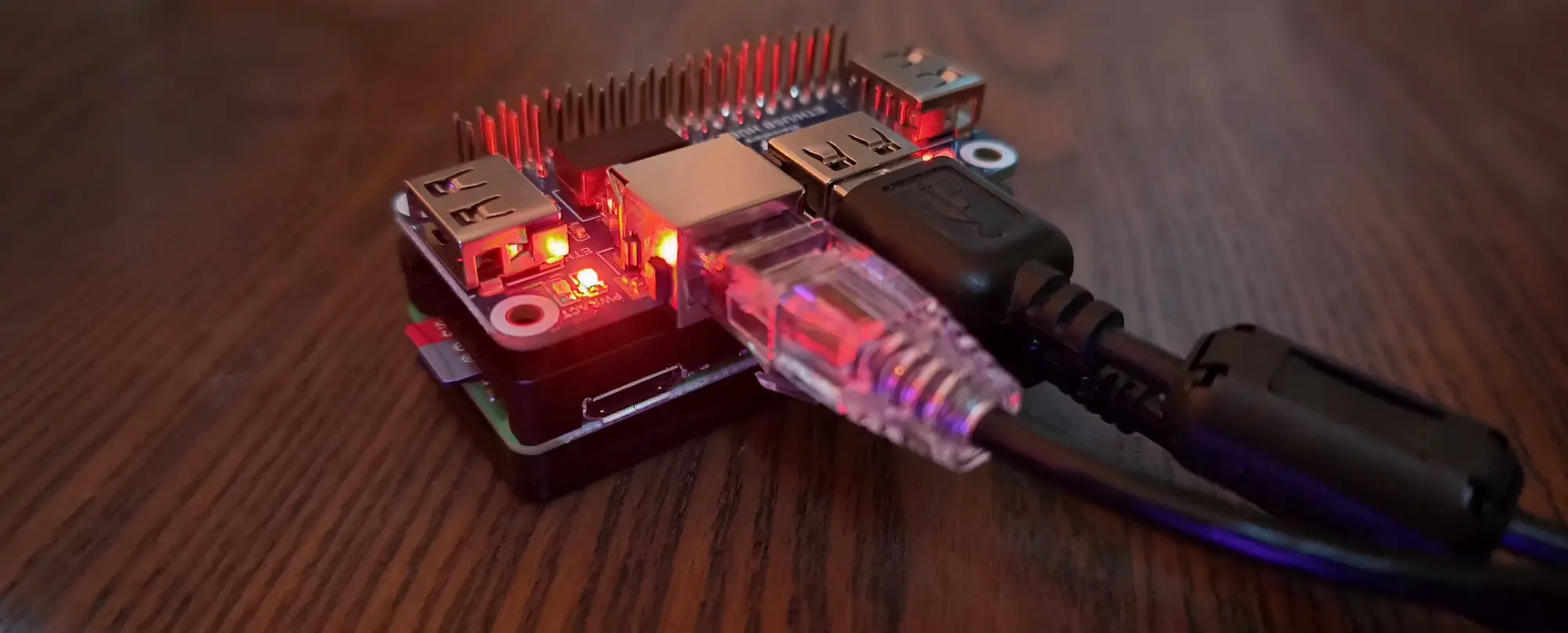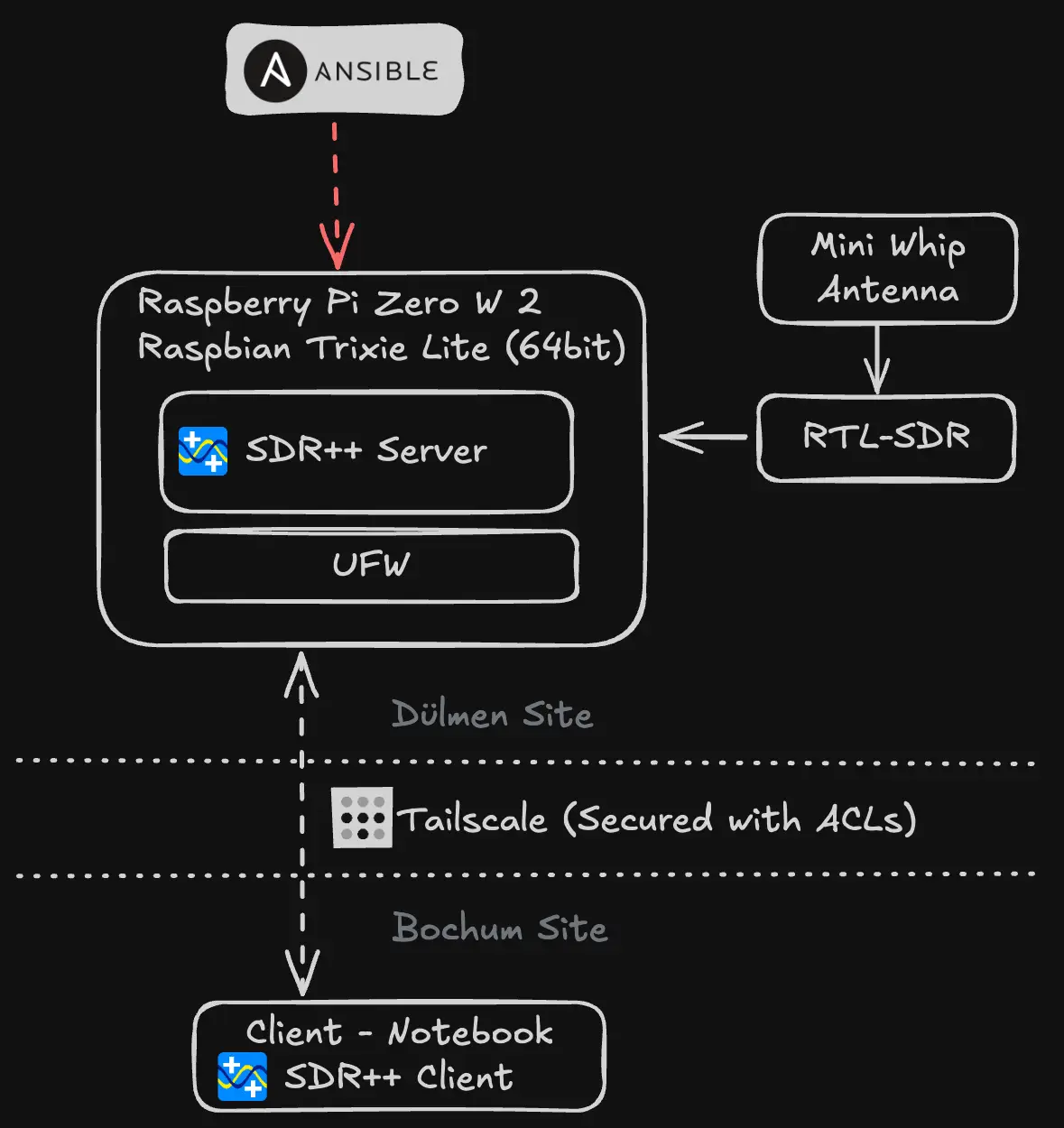Building SDRPi: A tiny SDR Station based on Pi Zero W 2

I’ve always been fascinated by software-defined radio (SDR) and the ability to explore the electromagnetic spectrum with relatively simple hardware. Recently, I decided to create SDRPi – a compact SDR station that I could build and deploy easily. This project combines the power of automation with tiny, efficient hardware to create something truly portable.
Key Facts

- Project Goal: Create a compact, automated SDR station for remote 24/7 monitoring using minimal hardware
- Core Hardware: Raspberry Pi Zero W 2, Waveshare Ethernet/USB HUB HAT, RTL-SDR dongle, mini-whip antenna
- Core Software: SDR++ (SDRPlusPlus) in server mode, RTL-SDR drivers
- DevOps Stack: Ansible for automation, systemd for service management, SSH for secure remote access, Tailscale for site-to-site VPN and ACL-based security
Why Raspberry Pi Zero W 2?
I chose the Raspberry Pi Zero W 2 as the foundation for SDRPi because of its incredibly compact size. Measuring just 65mm x 30mm x 5mm, it’s small enough to fit in my pocket, yet it has enough processing power to handle the full data throughput from an RTL-SDR dongle. I was initially skeptical about whether such a tiny computer could manage real-time SDR processing, but after testing, I’m impressed – it handles the data flow smoothly without breaking a sweat.
Expanding Connectivity with the Waveshare HAT
To make SDRPi fully functional, I added the Waveshare Ethernet/USB HUB HAT for the Raspberry Pi Zero W 2. This HAT provides Ethernet connectivity for reliable networking and additional USB ports, which are essential for connecting the RTL-SDR dongle and any other peripherals. It keeps the overall footprint small while giving me all the interfaces I need.
Antenna Choice: Mini-Whip for Wide-Band Coverage
For the antenna, I went with a mini-whip design. It’s compact enough to match the overall tiny profile of the setup, but it offers wide-band coverage that lets me tune across a broad range of frequencies. This combination of small size and broad capability is perfect for my portable SDR experiments.
The SDRPi Setup Process
I automated the entire setup using Ansible playbooks. SDRPi configures the Raspberry Pi with secure SSH access, installs RTL-SDR drivers from source for optimal performance, and sets up SDR++ (SDRPlusPlus) in server mode. The result is a headless SDR station that runs 24/7 and can be accessed remotely.
Since I plan to deploy SDRPi at a remote location, the 24/7 access via Ethernet is crucial for reliable, continuous monitoring. One of the coolest features is how SDRPi uses SDR++ server mode. The Raspberry Pi handles the hardware interface and signal capture, while I do the heavy processing on my local machine. This gives me flexibility to monitor signals from anywhere without needing dedicated hardware at my desk.
Remote Access with Tailscale
For secure remote access to my SDRPi station, I’m using Tailscale to establish a site-to-site VPN. Tailscale creates a private network that connects all my devices securely, regardless of their physical location. This is perfect for accessing the Raspberry Pi at the remote site without exposing it directly to the internet.
The key benefits include:
- Encrypted Connectivity: All traffic between my devices and the SDR station is encrypted
- ACL-Based Security: I can define access control lists to specify exactly which devices can connect and what they can access
- Zero-Config Networking: Devices automatically discover and connect to each other through the Tailscale network
This setup allows me to securely monitor and control the SDR station from anywhere, whether I’m at home, traveling, or working remotely.
Try It Yourself
If you’re interested in building your own SDRPi setup, I’ve shared the project on GitHub at https://github.com/Menschomat/SDRPi. The repository includes all the Ansible playbooks and detailed instructions in the README. It’s designed to be easy to deploy on your own hardware, whether you’re using a Raspberry Pi Zero W 2 or adapting it for other models.
This project has been a great way for me to combine my interests in radio, embedded systems, and devops automation. SDRPi proves that you don’t need bulky equipment to explore the airwaves – sometimes, tiny is mighty!
